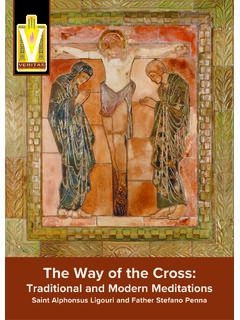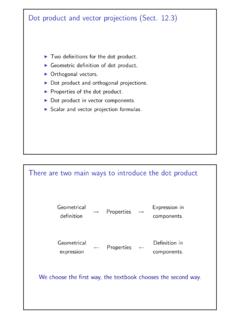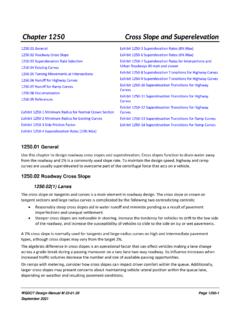Transcription of UNSUPERVISED CROSS-DOMAIN IMAGE GENERATION
1 Under review as a conference paper at ICLR 2017 UNSUPERVISEDCROSS-DOMAINIMAGEGENERATIONY aniv Taigman, Adam Polyak & Lior WolfFacebook AI ResearchTel-Aviv, study the problem of transferring a sample in one domain to an analog samplein another domain . Given two related domains,SandT, we would like to learn agenerative functionGthat maps an input sample fromSto the domainT, such thatthe output of a given functionf, which accepts inputs in either domains, wouldremain unchanged. Other than the functionf, the training data is unsupervisedand consist of a set of samples from each domain Transfer Network (DTN) we present employs a compound loss func-tion that includes a multiclass GAN loss, anf-constancy component, and a regu-larizing component that encouragesGto map samples fromTto themselves.
2 Weapply our method to visual domains including digits and face images and demon-strate its ability to generate convincing novel images of previously unseen entities,while preserving their excel in tasks that require making analogies between distinct domains, transferring ele-ments from one domain to another, and using these capabilities in order to blend concepts thatoriginated from multiple source domains. Our experience tells us that these remarkable capabilitiesare developed with very little, if any, supervision that is given in the form of explicit achievements replicate some of these capabilities to some degree: Generative AdversarialNetworks (GANs) are able to convincingly generate novel samples that match that of a given trainingset; style transfer methods are able to alter the visual style of images.
3 domain adaptation methodsare able to generalize learned functions to new domains even without labeled samples in the targetdomain and transfer learning is now commonly used to import existing knowledge and to makelearning much more capabilities, however, do not address the general analogy synthesis problem that we tackle inthis work. Namely, given separated but otherwise unlabeled samples from domainsSandTand amultivariate functionf, learn a mappingG:S Tsuch thatf(x) f(G(x)).In order to solve this problem, we make use of deep neural networks of a specific structure in whichthe functionGis a composition of the input functionfand a learned functiong. A compound lossthat integrates multiple terms is used. One term is a Generative Adversarial Network (GAN) termthat encourages the creation of samplesG(x)that are indistinguishable from the training samples ofthe target domain , regardless ofx Sorx T.
4 The second loss term enforces that for everyxinthe source domain training set,||f(x) f(G(x))||is small. The third loss term is a regularizer thatencouragesGto be the identity mapping for allx type of problems we focus on in our experiments are visual, although our methods are notlimited to visual or even to perceptual tasks. Typically,fwould be a neural network representationthat is taken as the activations of a network that was trained, , by using the cross entropy loss, inorder to classify or to capture a main application challenge, we tackle the problem of emoji GENERATION for a given facial a growing interest in emoji and the hurdle of creating such personal emoji manually, nosystem has been proposed, to our knowledge, that can solve this problem.
5 Our method is able to1 [ ] 7 Nov 2016 Under review as a conference paper at ICLR 2017produce face emoji that are visually appealing and capture much more of the facial characteristicsthan the emoji created by well-trained human annotators who use the conventional WORKAs far as we know, thedomain transferproblem we formulate is novel despite being ecological ( ,appearing naturally in the real-world), widely applicable, and related to cognitive reasoning (Fau-connier & Turner, 2003). In the discussion below, we survey recent GAN work, compare our workto the recent IMAGE synthesis work and make links to UNSUPERVISED domain (Goodfellow et al., 2014) methods train a generator networkGthat synthesizes samples froma target distribution given noise trained jointly with a discriminator networkD, whichdistinguishes between samples generated byGand a training set from the target distribution.
6 Thegoal ofGis to create samples that are classified byDas real originally proposed for generating random samples, GANs can be used as a general toolto measure equivalence between distributions. Specifically, the optimization ofDcorresponds totaking the most discriminativeDachievable, which in turn implies that the indistinguishability istrue for everyD. Formally, Ganin et al. (2016) linked the GAN loss to the H-divergence betweentwo distributions of Ben-david et al. (2006).The generative architecture that we employ is based on the successful architecture of Radford et al.(2015). There has recently been a growing concern about the uneven distribution of the samplesgenerated byG that they tend to cluster around a set of modes in the target domain (Salimanset al.)
7 , 2016). In general, we do not observe such an effect in our results, due to the requirement togenerate samples that satisfy specificf-constancy few contributions ( Conditional GANs ) have employed GANs in order to generate samples froma specific class (Mirza & Osindero, 2014), or even based on a textual description (Reed et al., 2016).When performing such conditioning, one can distinguish between samples that were correctly gen-erated but fail to match the conditional constraint and samples that were not correctly is modeled as a ternary discriminative functionD(Reed et al., 2016; Brock et al., 2016).The recent work by Dosovitskiy & Brox (2016), has shown promising results for learning to mapembeddings to their pre-images, given input-target pairs.
8 Like us, they employ a GAN as wellas additional losses in the feature- and the pixel-space. Their method is able to invert the mid-level activations of AlexNet and reconstruct the input IMAGE . In contrast, we solve the problem ofunsupervised domain transfer and apply the loss terms in different domains: pixel loss in the targetdomain, and feature loss in the source class of very promising generative techniques that has recently gained traction is neuralstyle transfer. In these methods, new images are synthesized by minimizing the content loss withrespect to one input sample and the style loss with respect to one or more input samples. The contentloss is typically the encoding of the IMAGE by a network training for an IMAGE categorization task,similar to our work.
9 The style loss compares the statistics of the activations in various layers ofthe neural network. We do not employ style losses in our method. While initially style transferwas obtained by a slow optimization process (Gatys et al., 2016), recently, the emphasis was put onfeed-forward methods (Ulyanov et al., 2016; Johnson et al., 2016).There are many links between style transfer and our work: both are UNSUPERVISED and generate asample underfconstancy given an input sample. However, our work is much more general in itsscope and does not rely on a predefined family of perceptual losses. Our method can be used in orderto perform style transfer, but not the other way around. Another key difference is that the currentstyle transfer methods are aimed at replicating the style of one or several images, while our workconsiders a distribution in the target space.
10 In many applications, there is an abundance of unlabeleddata in the target domainT, which can be modeled accurately in an UNSUPERVISED the impressive results of recent style transfer work, in particular for face images, one mightget the false impression that emoji are just a different style of drawing faces. By way of analogy,this claim is similar to stating that a Siamese cat is a Labrador in a different style. Emoji differfrom facial photographs in both content and style. Style transfer can create visually appealing faceimages; However, the properties of the target domain are review as a conference paper at ICLR 2017In the computer vision literature, work has been done to automatically generate sketches from im-ages, see Kyprianidis et al.
![arXiv:0706.3639v1 [cs.AI] 25 Jun 2007](/cache/preview/4/1/3/9/3/1/4/b/thumb-4139314b93ef86b7b4c2d05ebcc88e46.jpg)

![arXiv:1301.3781v3 [cs.CL] 7 Sep 2013](/cache/preview/4/d/5/0/4/3/4/0/thumb-4d504340120163c0bdf3f4678d8d217f.jpg)
![@google.com arXiv:1609.03499v2 [cs.SD] 19 Sep 2016](/cache/preview/c/3/4/9/4/6/9/b/thumb-c349469b499107d21e221f2ac908f8b2.jpg)














